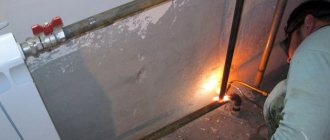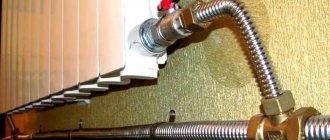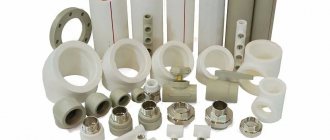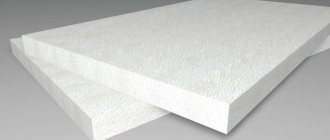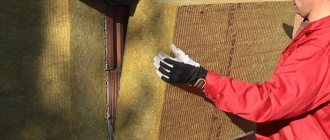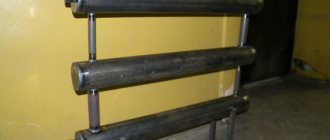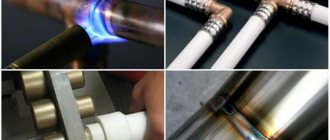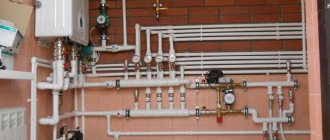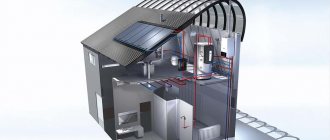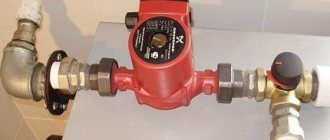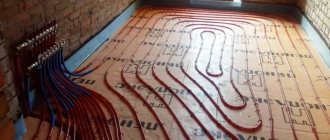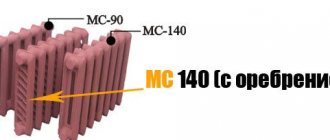Menu:
- Technical characteristics, advantages and disadvantages
- Using corrugation
- Calculations
- Popular questions and answers to them
- Briefly about the cost where to buy
- Installation and fastening
- Welding
- Connection of metal and plastic pipes
- Docking with fittings
- Video
Creating a heating circuit is quite a complex task. To solve this problem, metal pipes are traditionally used. They have excellent performance characteristics. Despite the emergence of polymer analogues, metal structures do not lose their popularity. Because they can withstand high temperatures and have high strength.
Technical characteristics, advantages and disadvantages
The properties of steel products depend on many factors. These include the production method and the characteristics of the steel grade used. Products are divided into welded and seamless. The first type is connected by welding. The second option is produced using special machines.
The key advantages of the products are:
- Availability. The price of metal heating pipes is relatively low.
- High strength. Circuits with a significant internal pressure are constructed exclusively from steel channels.
- Good gas tightness. This indicator for the products in question is very high. It plays a vital role in the construction of the heating circuit.
- Low thermal expansion. Therefore, there is no need to use thick-walled structures to install a heating system.
- Significant thermal conductivity. The metal gives off a significant amount of heat to the environment. Therefore, using steel products it is possible to make a heating system even without the use of radiators.
Metal channels also have disadvantages. They must be taken into account when arranging pipelines.
The disadvantages of the products in question include:
- High electrical conductivity. This imposes certain restrictions when arranging a heating circuit based on an electric boiler.
- Considerable rigidity. Bending structures can only be done by exposure to high temperature. To install the system, you need to use special fittings.
- Heavy weight. This complicates the transportation and installation of structures.
- Low resistance to corrosion processes. To avoid problems caused by oxidation, it is advisable to use galvanized or stainless steel.
Black steel products
There are several types of metal channels.
They can be made from the following types of steel:
- black;
- stainless;
- galvanized.
Products made of black steel were in great demand in the second half of the last century. As a rule, water-gas electric-welded structures were used to create a heating circuit.
Their properties are regulated by the state. standard 3262-75.
Below you can see the table of pipe sizes.
Today, designs with a diameter from six to one hundred and fifty millimeters are popular. There are products with larger cross-sectional sizes.
The key disadvantage of products made of black steel is their poor resistance to corrosion processes. As a result of oxidation, rust flakes and various unwanted deposits appear inside the products. All this negatively affects channel capacity.
The cost of such structures is quite low. But the duration of their operation also leaves much to be desired.
Galvanized products are resistant to rust. Therefore, their service life is significantly longer than that of the previous type of product. Moreover, the zinc layer only slows down the oxidation processes.
Galvanized ducts have more acceptable characteristics for creating heating circuits. They withstand pressure changes and high temperatures. Ideal for creating a central heating circuit. To install autonomous systems based on gas boilers, it would be more reasonable to use structures made of polymer materials.
Galvanizing also has disadvantages. During welding work, the zinc layer is damaged. Therefore, rust will inevitably occur in this place, which will have an extremely negative impact on the operation of the entire system. In addition, galvanized channels have a higher cost than products made of black steel or polymers.
Stainless steel is one of the best options for arranging heating pipelines. Such designs are durable. They are highly resistant to oxidation processes and have a significant safety margin. The disadvantages include the complexity of installing such channels and the high cost.
Steel 12Х1МФ
Low-alloy, heat-resistant structural steel. Pearlitic grade steel. Recommended application temperature up to 570-585 °C; Temperature of intensive scaling 600 °C; operating life - more than 10,000 hours.
Substitute: 12ХМФ.
Type of supply: Pipes TU 14-3р-55-2001, including long and shaped steel.
Application: For superheater pipes, pipelines and high pressure manifold installations; forgings for steam boilers and steam pipelines; gas turbine cylinder parts; for the manufacture of parts operating at temperatures of 540-580°C.
Using corrugation
Corrugated stainless steel structures are a good material for arranging heating systems in a private house or apartment. Products can have a diameter from fifteen to thirty-two millimeters. Corrugations with a larger cross-section can be made to order.
The products in question can withstand temperatures over a wide range. Corrugation can be used at temperatures from -40 to +800 degrees. It is obvious that these designs are not applicable in such conditions. Plastic fittings used during installation can withstand temperatures up to one hundred and ten degrees.
Corrugated structures are characterized by high resistance to physical damage and pressure changes. Such products can withstand exposure to up to fifty atmospheres. In this case, the operating pressure is fifteen atmospheres.
Please note that flexible products are completely oxygen impermeable. In this case, the value of the roughness coefficient is only 0.008. If you follow the rules for using these structures, their service life will be at least twenty years.
Using corrugation has a number of advantages.
These include:
- environmental friendliness of products;
- long service life;
- significant length of measured segments, allowing you to create long sections without fittings;
- slight noise;
- low weight;
- ease of installation;
- resistance to mold and fungi;
- excellent smoothness of the internal walls, ensuring high permeability of the channels;
- resistance to temperature and pressure changes;
- high anti-corrosion properties and inertness to chemicals;
- good heat dissipation;
- significant strength;
- ideal design flexibility.
Thanks to its excellent technical characteristics, corrugation is widely used in heating systems. However, it is worth remembering the disadvantages of the type of steel pipes under consideration. These include:
- the need to provide protection from electrochemical corrosion processes;
- the thinness of the design and its poor resistance to physical influences (you need to install a special protective box);
- high heat transfer rates;
- the ability to accumulate dirt in the recesses between the ribs of the corrugation;
- significant cost.
Steel 30HGSA
Structural alloy steel. Chrome-silicon-manganese steel.
Substitute : 40HFA, 35ХМ, 40ХН, 25ХГСА, 35ХГСА.
Type of delivery: seamless hot-rolled pipes
Application: Various parts to be improved: shafts, axles, gears, flanges, casings, compressor blades operating at temperatures up to 200°C, levers, pushers, critical welded structures operating under alternating loads, fasteners operating at low temperatures .
Calculations
To create a heating system, you need to calculate the required power of the pipes. The reliability of the system will depend on this. It is important that during the winter season all rooms in a private house or apartment are heated evenly. This can be achieved by installing channels of sufficient diameter. To find out the required section size you need to use the following formula: D = sqrt ((314∙Q)/ (V∙DT)).
Below you will find out what these variables mean:
- sqrt – square root;
- DT is the temperature difference between the inlet and outlet;
- V is the speed of the carrier;
- Q—heat flow;
- D – internal diameter indicator.
To simplify the calculations, you can use the corresponding table. It will save time .
Choosing the right pipe size for autonomous heating at home
To select the required cross-section of a steel pipeline, a thermal engineering calculation is required. Only a specialist can take into account all the nuances. But you can make an approximate selection yourself using the table. To do this you need to know the following parameters:
- The speed of the coolant, optimally it should be 0.3-0.7 m/s, it is not recommended to exceed the threshold of 1.5 m/s.
- The difference (?T) between the temperature of the water coming from the boiler and returning to it is usually taken equal to 20-25°C.
- The amount of heat (Q) that the heating must provide. With a ceiling height of up to 3 meters and good insulation of the building, it is believed that to heat a 10 m2 room you will need 1 kW of thermal power plus 15-20% of the reserve.
- Coolant flow, which depends on the previous parameters and is determined by the formula C=0.86*Q/T (kg/hour).
Having determined the parameters listed above, you can begin to select the internal diameter of the steel pipe according to the table. The difference (?T) in this case is taken equal to 20°.
| Inner diameter | Coolant movement speed, m/s | ||||||||||
| mm | inches | 0,3 | 0,4 | 0,5 | 0,6 | 0,7 | |||||
| Q, kW | C, kg/hour | Q, kW | C, kg/hour | Q, kW | C, kg/hour | Q, kW | C, kg/hour | Q, kW | C, kg/hour | ||
| 15 | ½ | 4,31 | 185 | 5,75 | 247 | 7,19 | 309 | 8,6 | 371 | 10,06 | 433 |
| 20 | ¾ | 7,66 | 330 | 10,219 | 439 | 12,77 | 549 | 15,33 | 659 | 17,88 | 770 |
| 25 | 1 | 11,975 | 515 | 15,97 | 687 | 19,96 | 858 | 23,95 | 1030 | 27,94 | 1200 |
| 32 | 1 ¼ | 19,62 | 844 | 26,16 | 1125 | 32,7 | 1406 | 39,24 | 1687 | 45,78 | 1970 |
| 40 | 1 ½ | 30,66 | 1318 | 40,88 | 1758 | 51,09 | 2197 | 61,31 | 2636 | 71,53 | 3080 |
| 50 | 2 | 17,9 | 2060 | 63,87 | 2746 | 79,84 | 3433 | 95,8 | 4120 | 111,77 | 4810 |
The diameter of the steel pipe selected from the table for the heating system is internal, and the external is determined by the thickness of the walls. For pipe products of the VGP category, the diameters and other characteristics of which are regulated by GOST 3262, there are three series with different wall thicknesses - light, regular, reinforced.
Popular questions and answers to them
When installing heating systems, many people have typical questions.
Below we will answer the most popular of them:
- How to paint metal structures? To solve this problem, several types of paints are used: acrylic, alkyd enamel and water-dispersion. Each of the listed options is perfect for solving this problem.
- Should old Soviet pipes be replaced? If we are talking about black steel, then definitely. The service life of such structures is about twenty years. Accordingly, channels installed more than two decades ago need to be replaced with new ones.
- Plastic or metal products? If we are talking about creating an autonomous heating system in a private house or apartment, it is better to use polypropylene or metal-plastic channels. For central heating systems, metal must be used.
- What is the service life of iron structures? It all depends on the quality of the material. Black steel lasts up to twenty years. Galvanization can be used for thirty years. Stainless steel can last over fifty years.
Briefly about the cost where to buy
The price of metal structures is indicated either per meter or per ton. Be sure to pay attention to this point. The cost of metal channels varies over a very wide range. The price depends on the quality of the material, production technology, wall thickness and other properties of the product.
Structures made of black steel are the cheapest. Next comes galvanization, which costs a little more. Stainless steel is the most expensive. However, as you have already learned, pipes made from it are the most reliable. Corrugated stainless steel channels are the most expensive.
The easiest way to order the products in question is from companies specializing in the sale of rolled metal products. It is advisable to deal with structural manufacturers or their official dealers. This will allow you to purchase the products you need at an affordable price.
In some cases, it makes sense to buy used pipes. The main thing is that they are in good condition. When purchasing, be sure to ask for a certificate of conformity. This will allow you to avoid purchasing inferior products.
Installation and fastening
There are two methods of installing metal structures: welding and connection using fittings. Each of them has its own characteristics. Also, when installing heating systems with your own hands, it is important to correctly wire the radiators. This operation must be performed in stages, following the technology. Do not forget about the correct fastening of metal pipes to the wall.
To create bends and turns of the contour, it is better to use the appropriate shaped parts. It is not recommended to bend metal structures by welding. During this operation, the channel performance may deteriorate.
The combination of metal and plastic products also has its own characteristics. Below we will talk about this in more detail.
Seamless pipelines
Seamless steel pipe for heating is produced by hot deformation from a monolithic part, which has the shape of a cylinder. They are called differently - solid-bent.
Specifications
This rolled metal product does not contain any seams or joints. They are made on special machines.
Depending on the type of production, seamless materials can be hot-rolled, solid-formed or cold-rolled.
Solid bent products get their name from the production method. This type of building materials is characterized by high strength. Also, seamless options are classified as thick-walled blanks.
In this case, a special type of steel is used for production. Various non-ferrous metals are also used for such production. This is used for pipe rolling, which transports aggressive chemicals.
When talking about this type of product, one cannot ignore an interesting fact. Hot-rolled pipes are widely used in cryogenic technology.
Welding
Traditionally, electric welding was used to connect metal channels. This operation allows you to reliably connect two products together. The quality of its implementation must be extremely high. The performance of the entire circuit depends on how well the joint is made. If the welding was done poorly, a leak may occur in the near future.
Connections by welding can be made:
- in the corner;
- end-to-end;
- vtavr;
- overlap
Note that when installing heating ducts, butt welding is predominantly used. This method allows you to create the most reliable joint. Therefore, always connect products exclusively end-to-end.
Connection of metal and plastic pipes
Structures made of steel and polymers are joined in two ways.
Combinations of products from different materials can be:
- Rezbovym.
- Flange.
For joining small structures, a threaded connection is most often used. For this purpose, special shaped parts are used, which consist of two parts. The first is a metal thread, and the second is a plastic coupling. In this way, a transition is made from one pipe to another. The joining method is suitable for channels with a cross-sectional size of up to forty millimeters.
The flange connection is permanent. It is used for large diameter structures. This connection allows you to quickly assemble or disassemble any section of the pipeline. The joining of metal-plastic or plastic structures to steel ones is carried out using special components - flanges.
